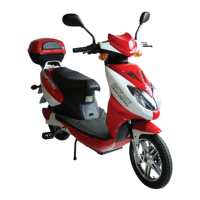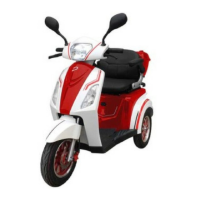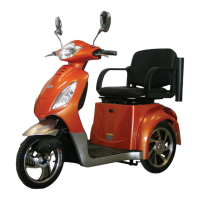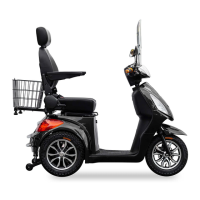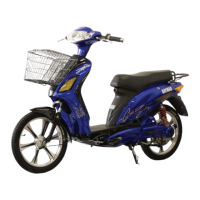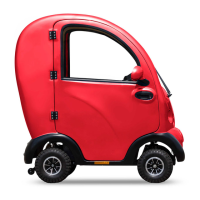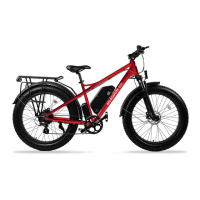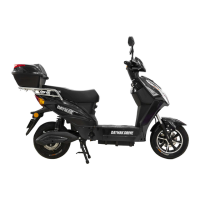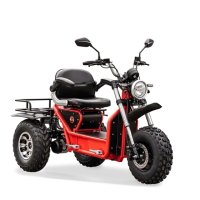Do you have a question about the Daymak Rome 72V and is the answer not in the manual?
Discusses the benefits and characteristics of electric bicycles for urban transportation.
Advises checking local laws regarding electric bicycle usage and regulations.
Daymak disclaims liability for improper use or unauthorized service of the product.
Illustrates and labels various parts of the electric bicycle.
Illustrates and labels parts of the handlebars and controls.
Warns that e-bikes are dangerous for those without cycling experience.
Provides key advice on speed, laws, sobriety, and sharing the road.
Lists essential items to carry while riding the e-bike.
Emphasizes regular checks for safety and proper functioning before riding.
Explains the correct way to hold handlebars for control and brake access.
Details activating the e-bike and using the throttle for acceleration/deceleration.
Explains how to use the front and rear brakes for stopping the e-bike.
Offers advice on brake maintenance and performance in different conditions.
Describes horn, turn signals, and lights for visibility and communication.
Explains the benefit of pedaling for increased range and assistance.
Advises on operating the e-bike in rain and its effect on brakes.
Warns against immersing the motor in water to prevent damage.
Discusses battery performance and potential wear in cold temperatures.
Details how to open, close, and use the rear storage compartment.
Explains the procedure for opening and closing the seat trunk.
Provides step-by-step instructions for safely parking and securing the e-bike.
Advises against exceeding the e-bike's maximum load capacity to prevent damage.
Explains how to disconnect the circuit breaker for safety or storage.
Provides guidance on proper procedures for storing the e-bike long-term.
Explains how to check the battery charge level on the dashboard.
Discusses factors affecting battery range and capacity.
Offers tips on driving habits to conserve battery power and extend range.
Warns against using non-specified chargers to prevent damage and injury.
Provides step-by-step instructions for charging the e-bike's battery.
Offers advice on charging, full charging, keeping charged, and storage conditions.
Warns against placing Lead-Acid batteries on concrete due to power drainage.
Discusses battery performance in cold and its impact on lifespan.
Details safety precautions for handling the battery to prevent injury.
Discusses battery lifespan and when replacement is needed.
Advises on proper disposal of used batteries at recycling facilities.
Warns about using correct battery types to avoid damage and voiding warranty.
Details specifications of the rear hub motor, including power and torque.
Explains the function of the freewheel for coasting and power saving.
Describes the intelligent control system and its functions.
Explains the governor's role in regulating speed and its impact on warranty.
Details the hydraulic disc brake system, maintenance, and adjustment.
Describes the chain and pedals as the human-powered drive train.
Explains the function of shock absorbers and their resilience.
Lists dimensions, weight, loading capacity, and speed/mileage.
Details motor, charger, and battery specifications.
Presents a visual representation of the e-bike's electrical system connections.
Advises on maintaining proper tire pressure for performance and damage prevention.
Explains the complexity of replacing flat tires, especially the rear.
Describes the function of drum brakes and their servicing needs.
Details the process for adjusting brake cable tension for drum brakes.
Advises against self-servicing the motor and recommends dealer service.
Emphasizes the importance of lubricating the chain for proper function.
Discusses checking tire pressure for ride comfort and seeking service if needed.
Provides guidance on when and how to bring the e-bike for professional service.
Details weekly cleaning procedures and checks for wear.
Recommends lubricating parts for better performance and quieter operation.
Advises on storing the bike properly to protect it from weather elements.
Outlines a quick pre-ride safety check of key components.
Details monthly cleaning and inspection for wear.
Describes quarterly inspection of frame, tires, and battery range.
Covers semi-annual inspection of all components and connections.
Recommends an annual tune-up, including battery discharge and tire replacement.
Lists provinces where e-bikes are legalized and treated as bicycles.
Defines an e-bike based on motor power and speed capabilities.
Outlines where e-bikes are permitted to travel and who can ride them.
Details requirements like no license, no insurance, age, and helmet.
Lists mandatory equipment and safety gear for e-bikes.
Covers fines for violations and the implications of impaired driving.
Addresses confusion regarding the definition and treatment of e-bikes as bicycles.
